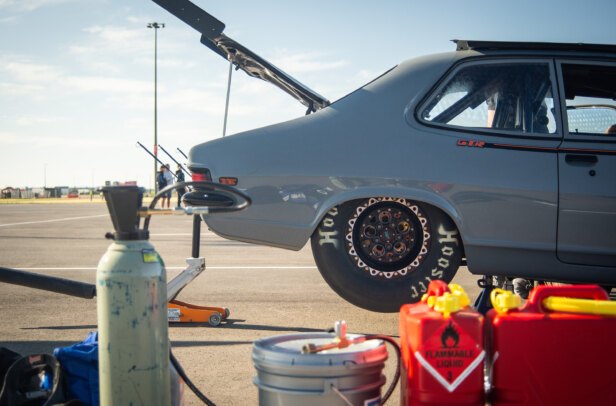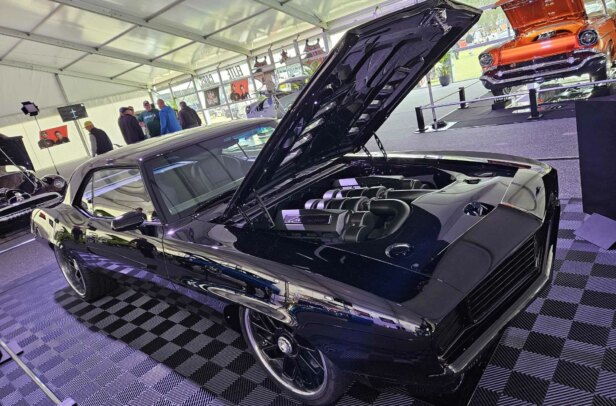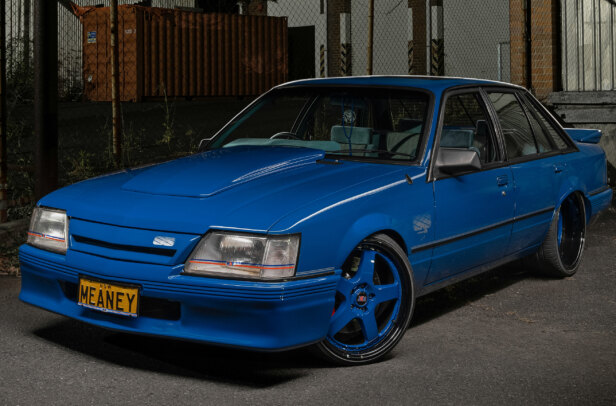There was once a time when every town in Australia was split broadly into two camps. Not along religious, economic or political lines, but automotive. For most folks, you were born into a Ford family or a Holden family. Chryslers were an outlier, with Volvos the domain of geography teachers in shorts and long socks.
First published in the November 2023 issue of Street Machine
As such, children were indoctrinated accordingly. Holden kids could recite each model from the 48-215 onwards. Ford kids as young as five could expertly explain the difference between an XL and XM Falcon.
These days, not so much. The automotive landscape is completely different, and locally made cars are as dead as the dodo. SUVs rule the sales roost and electric cars are on the rise. The old tribal rivalries no longer dominate the schoolyard. And that’s assuming the kids are even interested in cars; more and more youngsters aren’t even getting a licence.

However, there are still families bringing their kids up right. And some young ’uns, lord bless them, are finding their way to the real deal through their own initiative.
The first Holden rolled off the production line 75 years ago, so we reckoned it was time to help the next generation of Iron Lion fanatics come to grips with some of the finer details of the marque’s grand history. So close TikTok, put the PS5 down and gather your progeny around the kitchen table for our ultimate 75th-anniversary Holden identification and history guide.
48-215 (FX)
November 1948 – October 1953





The first thing to know is that only absolute nerds get wound up about calling the first Holden by its official designation of 48-215. Nope, the people have been calling it the FX for decades, and that is just the way it is!
You can instantly spot an FX from the front by the big, 29-tooth grille. They had H-O-L-D-E-N spelt out on both the bonnet and bootlid, and the wings of the single tail-light were painted body colour.

The FX came with neither indicators nor reflectors from the factory, though many cars were fitted with them later on.
Mechanically, the FX ran the 132ci ‘grey’ six, a three-speed, non-synchro-in-first gearbox, tiny drum brakes, and skinny 15-inch rims.
FJ
October 1953 – July 1956



While the FX was available only as a sedan or a ute, its successor, the FJ, added the first panel van to the Holden line-up.
You can identify an FJ by its smaller grille, torpedo-shaped tail-light and L-shaped bootlid handle (as opposed to the FX’s T-shaped one).


The upmarket Special model was introduced with the FJ, offering optional two-tone paint, chrome reflector-housing wings, additional chrome trim and (gasp!) door locks on both the driver- and passenger-side doors.
FE
July 1956 – May 1958





Next up we have the FE, which copped a brand-new, locally designed look. This time a station wagon joined the Holden fray for the first time.
The easiest way to spot an FE is to look for the cool round Holden badge in the middle of the bonnet, round front blinkers, and the egg-crate grille. We’re assuming you kids know what an egg crate looks like, of course!

Inside, the FE was much more flash than the staid FJ, with a chrome jukebox-style speaker for the wireless. A jukebox was, oh jeez,
an ancient iPod?
FC
May 1958 – January 1960






The FC was even more rock ’n’ roll than the FE, with a bolder grille and chrome fins over the top of the rear guards. And if that doesn’t help you spot one, look for horizontal blinkers on the front.
By the end of 1958, Holden owned 50.1 per cent of the new-car market, with 191,724 FCs being sold in total.
FB
January 1960 – May 1961






The early years of Holden styling always lagged behind the US trends, which is nowhere more obvious than in the FB Holden, which lobbed three years after the 1957 Chevrolet it was influenced by.
While the FB at first blush looks totally different to the FC it replaced, the bootlid – and tailgates in utes and vans – were carry-over FC items. The grey motor grew to 138ci, offsetting the fact that the FB was a heavier unit.


Fun fact: the FB was the first Holden produced in left-hand-drive for export.
EK
May 1961 – July 1962






Here is how you spot a Standard EK over a Standard FB: The EK’s red plastic grille badge is a giveaway, as are the over-riders – on an FB they sit on top of the bumper, while on an EK they extend to the bottom. The grille design is also different, with the EK’s indicator/parkers spaced more widely apart and built into the upper grille bar.
For Specials, the FB had a wide side flash, whereas its EK succesor just came with a single mould each side that ran the whole length of the car.


The big news with the EK was the introduction of an automatic gearbox for the first time: the three-speed Hydramatic. Autos accounted for 25 per cent of EK sales, but were painfully slow.
EJ
July 1962 – August 1963






The EJ was the swansong for the venerable grey motor that had powered all Holdens since 1948. Holden’s first luxury model, the Premier, was also introduced with the EJ.
From the front, the easiest ways to identify an EJ are the V-shaped styling lines on the bonnet and the badge moulded into the bonnet’s leading edge. The EJ and the EH that followed it have significantly different panelwork in some areas: check the tail-lights, roofline and the way the EJ’s gentle fins echo the shape of the boot. All these features were restyled for the EH.
EH
August 1963 – February 1965






Introduced in August 1963, the EH was one of the most successful and fastest-selling Holdens ever, with a total of 256,959 built in a little less than two years. The introduction of the 149 and 179 red motors saw a quantum leap in performance and saw Holden produce its first homologation special, the S4.
The EH sedan is easy to pick from the EJ from the rear by its flatter rear ’screen, vertical tail-lights and squared-off boot. The EJ’s smooth fuel filler flap was also replaced with a more conventional external round cap. EH wagons were fitted with the vertical tail-lights, but utes and vans stuck with the EJ design.
The EH also saw the introduction of power steering, a very rare option indeed.
HD
February 1965 – April 1966


The styling of the HD was controversial in its day, but it makes it easy to pick one out in 2023! At the front, look for the ‘kidney crusher’ front guards that protrude forward of the tail-lights. At the rear, you’ll see a concave back window and wrap-around tail-lights.
Holden managed to sell 178,927 HDs, and the model saw the introduction of the company’s first performance engine – the twin-carb 179 X2. Other advances saw the two-speed Powerglide auto replace the ageing Hydramatic, and disc brakes were offered for the first time.
HR
April 1966 – January 1968




The HR’s glow-up over the HD included vertical tail-lights and a wider rear ’screen. The kidney-crusher front guards were softened, and the whole deal sat half an inch closer to terra firma. But if you are still stumped, look out for the HR’s circular indicators on the front grille.
These mods worked a treat, with the HR selling 252,352 units in 22 months. It also saw the first four-speed transmission offered as an option from Opel. Engines grew to 161 and 186 cubes. The HD’s twin-carb X2 motor was initially carried over (in 186 form) to the HR, before being replaced by the twin barrel-equipped 186S.
HK
January 1968 – May 1969


Holden really came of age with the HK. The all-new design was bigger, lower and sported flared guards.
The range expanded again with the introduction of the Monaro coupe and the big-bummed luxury Brougham. The iconic Belmont and Kingswood badges were introduced, with the Premier (now with quad headlights!) remaining the range-topper of the regular-sized Holdens.
The options list exploded, too, topped by the introduction of the 307 and 327 Chevrolet V8s. And the introduction of an all-synchro three-speed was met with relief by learner drivers everywhere.
HT
May 1969 – July 1970



The HT was a light facelift of the HK, with the rear end scoring updated wrap-around tail-lights and a new grille up front.
Engine-wise, the 327 Chev V8 was replaced by the 350, and the Aussie-made 253 and 308 V8s were introduced (the latter coming onstream only after Holden exhausted its stockpile of 307s.)
The 350 remained exclusive to the Monaro GTS, which became Holden’s homologation special. Wheels magazine returned a 125mph top speed and 15.6-second quarter mile in that car in October 1969, the same month Colin Bond and Tony Roberts took out the Hardie-Ferodo 500 at Bathurst piloting a GTS.
HG
July 1970 – July 1971







The HG was another minor facelift. The big news was the introduction of the three-speed Trimatic auto, which was available on every model except the Monaro GTS 350. And in good news for everyone, you could no longer order a V8 car with drum front brakes!
The HG sold 149,640 units in just 12 months, and was also exported to South Africa as the Chevrolet Kommando, Constantia and El Camino ute.
HQ
July 1971 – October 1974





The HQ was another landmark car, with 485,650 units sold. It was larger than the HG and was based on a semi-chassis frame with coil suspension all ’round.
The model range grew again, with the long-wheelbase Statesman replacing the Brougham, and the One Tonner joining the commercial range. The SS sedan and the first Sandman van were introduced too, both based on the Belmont, while the Monaro GTS range was extended to include a four-door version in March ’73.
ID hint: the Statesman and Premier had twin headlights each side; Monaros, Kingswoods and Belmonts made do with just one.
HJ
October 1974 – July 1976




The HJ facelift saw the elegant HQ’s styling blunted to give a more macho look. The Statesman range was now topped by the Caprice. And the 350 Chev? It was, by now, merely a memory.
The HJ also spawned one of Holden’s most unusual exports – the 13B rotary-powered Mazda Roadpacer.
HX
July 1976 – October 1977




The HX was another minor facelift, but one that saw the introduction of smog-strangled engines to meet Australian Design Rule 27A.
The two-door had its swansong with 600 LE coupes, which were stacked with goodies including air con, eight-track players, power windows, gold pinstriping and honeycomb-style rims. It did not, however, bear a Monaro badge, though the name did live on with the HX GTS Monaro sedan.
HZ
October 1977 – April 1980




Handling was never a strong point of stock HQ-HX Holdens, so the introduction of Radial Tuned Suspension for the HZ was a godsend.
The Belmont poverty-pack was dropped and replaced with the Kingswood SL, while the Monaro badge disappeared in favour of a four-door sports sedan known simply as the GTS.
The HZ was at first sold side-by-side with the VB Commodore and UC Torana, before being pensioned off. Look for the egg-crate grille and boot hump to differentiate the HZ from the HX.
WB
April 1980 – Late 1984


Even after the HZ was retired, the body style lived on for a few more years in the form of the WB commercial and Statesman ranges.
The Kingswood name could still be found on the ute, but the Sandman was dropped as an option for the utes and vans. The HDT Magnum brought some attitude to the Stato. Thanks, Brocky!
There were 60,231 WBs produced before they were discontinued in late 1984. This marked the last of the Holden panel vans, and the last ute until the VG Commodore.
VB
October 1978 – March 1980





Holdens finally stopped expanding in size and started shrinking instead with the debut of the VB Commodore.
Holden was betting that the worldwide trend for smaller cars would continue in the wake of the 70s fuel crisis, and combined the German-designed body with Aussie mechanicals, steering, suspension and many other refinements.
The new car brought mostly new nomenclature, with the plain Commodore as the pov-pack, the SL as the volume seller and the SL/E as the luxury machine.
VC
March 1980 – October 1981



The next Commodore scored an egg-crate grille (now on its third comeback!) and introduced the option of the (shudder) Starfire four-cylinder motor. The sixes and eights copped a much-needed upgrade to XT5 spec, including electronic ignition.
Shadowtone (aka two-tone) paint made a return to the options list after a 20-year break, and cruise control joined the party for the first time. And let’s not forget, the first HDT Commodore also made its debut.
VH
October 1981 – February 1984


Aside from the introduction of a five-speed ’box for the six-pot, the VH was more about refinement than major changes over the VC. The most notable exterior change was a slatted grille replacing the old egg crate.
The SS badge was introduced for the VH, supplemented by Group One, Group Two and Group Three versions by HDT.
By now, the Commodore and Statesman shared showroom space with a fleet of both locally assembled and imported Holdens, including the Camira, Shuttle, Rodeo, Jackaroo and the evergreen Gemini.
VK
February 1984 – February 1986




After three models of gradual improvement, the VK Commodore brought out the big guns.
Styling made a leap forward, with an extra side window giving the car a longer, lower look, while the new three-louvre grille wrapped into the front bumper. The model names also copped a shake-up, resulting in SL, Executive, SS, Berlina and Calais.
The unloved four-banger, the 2.85-litre six and the 4.2-litre V8 were dropped. The 3.3-litre six copped the option of EFI, and the V8 was slimmed down to 4.9 litres to meet Group A touring car homologation regs. Best of all, the Calais scored a vacuum fluorescent digital dash. This was high-tech stuff!
VL
February 1986 – August 1988





The final first-gen Commodore took more big strides. The Holden six was finally retired, replaced with an exquisite 3.0-litre Nissan mill, including the optional turbo.
The styling was another revolution, with a sloping nose at the front and a built-in airfoil on the boot. The Calais scored its own vibe, with pop-up headlight ‘eyebrows’ and – you guessed it – an egg-crate grille.
While Holden had previously planned to can the V8, the V8s ’til ’98 campaign helped convince the company to rework the old girl for the unleaded petrol era.
Midway through the VL’s lifespan, Holden and Peter Brock parted ways, resulting in the first EFI Holden V8, the SS Group A SV, better known as the Walkinshaw.
VN
August 1988 – September 1991




Bigger was better in the late 80s, and the second-generation Commodore grew in size accordingly.
The Nissan six was replaced by the 3.8-litre Buick mang motor, while the Holden V8 was now EFI-equipped across the board.
The ute and luxo Statesman models made a comeback midway through the VN’s run, known as the VG and VQ respectively. The VN Group A was Holden’s final homologation special, complete with twin-throttle intake and a six-speed ’box.
The VN also spawned a badge-engineered version in the form of the Toyota Lexcen.
VP
September 1991 – July 1993


The VP looked fairly similar to the VN, although the semi-transparent grille on the Executive and Berlina is a good giveaway. You can also look out for the circular badge on the bonnet of all models.
Under the skin, there were significant upgrades, including ABS and IRS, which were introduced as standard on the Statesman first and later on the Calais and SS, as well as being optional for the Exec and Berlina.
Most models scored remote central locking as standard, as well as a much-needed (though still inadequate) anti-theft system.
VR
July 1993 – April 1995



The VR make-over turned the ugly-duckling VP into a beautiful swan. Outside, there was sleeker sheet metal at both ends and rounded rear wheelarches instead of the squared-off versions seen on the VN and VP, while inside was a smoothly sculpted dash.
There was a new and much-improved front suspension design, a wider track, and the 4L60E electronic four-speed auto replaced the TH700.
The big news engine-wise was the introduction of a 5.7-litre stroker version of the V8, available only on the HSV Senator and GTS and dubbed the 215i.
The Statesman was upgraded to VR specs, complete with new rear sheet metal that recalled the early-90s Oldsmobile Cutlass Supreme.
VS
April 1995 – August 1997




Visually, the VS got the mildest facelift over the VR, but it did see a new lion logo and the use of oval side indicators.
Of more importance to us was the introduction of the Ecotec V6 (the name an acronym for Emissions and Consumption Optimisation through TEChnology), which marked a great leap forward in refinement, along with decent improvements to both grunt and economy. A supercharged, auto-only V6 was also introduced, exclusive to the Calais and Statesman twins.
The Toyota Lexcen concept also died out with the VS, upsetting no one.
VT
August 1997 – June 1999

Holdens jumped up a size again when the VT lobbed in 1997. The new body was longer, wider and swoopier than any Holden in history. While the VT was intended to be based on the Opel Omega, it shared very little with its German cousin.
The Ecotec V6s returned with only minor changes, but the Holden V8 went out with a bang for the VT, having been treated to some internal upgrades, sequential injection and the option of the slick Getrag five-speed. IRS became standard throughout the range.
There was no VT ute, so the VS III ute (complete with the upgraded V8 if you so chose) was left to carry the torch.
VT II
June 1999 – October 2000

Visually, the VT II was a mild refresh that included new wheel trims, mags and grilles. The clear side and rear blinker lenses (instead of the VT’s amber ones) are the easiest way to spot them.
But the big news was the introduction of the LS1 V8, known in Holden-speak as the Gen III. It was available on every model, right down to the Executive. Great times!
The WH Statesman lobbed in 1999, to the relief of real estate agents and mid-tier ‘colourful racing identities’ everywhere.
VX
October 2000 – September 2002



While VX itself was a mild facelift, it also begat two of the most important models in latter-day Holden history: the new-age V2 Monaro and the mighty VU ute.
The Monaro was available in supercharged V6 form as the CV6, and in proper LS1 form as the CV8. Almost nobody bought the CV6.
The ute sat on the same long-wheelbase chassis as the wagon and Statesman, meaning one could jam a chook-chaser in the back without too much trouble.
VY
September 2002 – August 2004




The VY sported sharp new styling and a swish dashboard redesign that saw the model sell like hotcakes.
Holden was in a new golden era, with new variants popping up everywhere. The One Tonner returned to the Holden line-up for the first time since the WB, and the four-door Crewman ute was introduced to the delight of chiropractors everywhere.
The VY model also introduced all-wheel drive, albeit in V8 form only. The AWD running gear was fitted to the wagon as the Adventra, then the Crewman Cross 8, as well as the Avalanche and Avalanche XUV derivatives from HSV.
The Statesman and Caprice got an update in May 2003 as the WK series.
VZ
August 2004 – July 2006





Visually, the VZ upgrade appeared minor, but under the skin sat Holden’s first all-new V6 engine since 1988. The 3.6-litre, DOHC Alloytec V6 was expected to be a revelation after the inherent gruffness of the outgoing, pushrod Ecotec, but while it offered as much as 190kW, it lacked the low-down shove of the engine it replaced.
HSV started installing the mighty 6.0-litre LS2 across its RWD VZ range, with the AWD Coupe 4 and Avalanche twins retaining the LS1.
The DOD-equipped L76 V8 was brought onstream for the late VZ to comply with emissions standards.
While the VZ sedans ended in July 2006, the wagons and utes rolled on for over a year into the reign of the subsequent VE.
VE
July 2006 – May 2013




The VE was a true clean-slate design, designed from the outset to be manufactured in both left- and right-hand drive. The car was built on its own Zeta platform, which was also used as the basis for the fifth-generation Chevrolet Camaro.
Big changes included the introduction of the Sportwagon, which was designed to appeal to retail buyers rather than the dwindling fleet market. The range was rationalised heavily, with the Monaro, One Tonner and Crewman all failing to make the cut, but the Statesman/Caprice lived on as the WM due to export potential. The Executive and Acclaim nameplates were also retired, replaced by the Omega.
The HSVs of the day were dubbed the E-Series, with the top model being the LS7-powered W427.
VF
June 2013 – September 2015




With fleet sales dying off, Holden redoubled its efforts to focus on attracting private buyers. As a result, the VF was sportier and more premium-feeling both inside and out, across the range. It was crammed with tech too, including a reversing camera, blind-spot monitor, lane departure warning system, collision avoidance system, head-up display and automatic parking.
Both the Omega and the Berlina nameplates were discontinued, replaced by the Evoke.
HSV versions of the VF were dubbed the Gen-F and saw the arrival of the mighty, supercharged LSA.
VF II
September 2015 – October 2017



The VF II, released in 2015, was all about the 6.2-litre, 304kW (407hp) LS3 V8. Bigger brakes, rorty exhaust, 570Nm of torque and a staggering 6600rpm redline could be specified in the Calais, Calais V, Caprice, and the Commodore SS and SS-V, along with an array of special editions that were rolled out as production drew to a close in late 2017.
The VF II’s revised front bar harboured a small ‘LS3’ badge on the variants that mattered, as well as functional bonnet vents. Holden went so far as to shorten the diff ratios, too, contributing to the VF II’s neck-snapping performance.
The VF II stands as a love letter and thank-you note to the enthusiasts for whom Holden was life. It was the ultimate driver’s car, with staunch looks, classy interior and unrelenting V8s.
HSV stepped up to deliver the GTS-R and GTS-R W1 swan-songs, etching the VF in history as one of the greatest performance cars constructed on our shores.




Comments